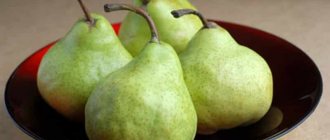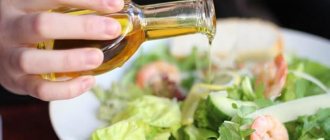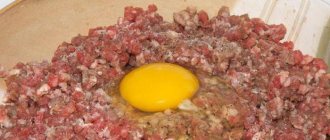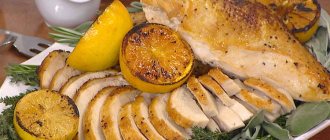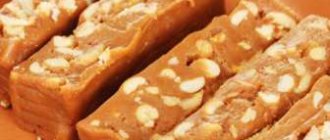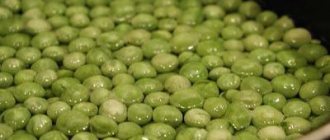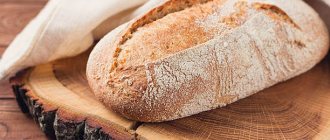Possible reasons for restricting access:
Access is limited by court decision or on other grounds established by the legislation of the Russian Federation.
A network address that allows you to identify a site on the Internet is included in the Unified Register of domain names, page indexes of Internet sites and network addresses that allow you to identify sites on the Internet containing information the distribution of which is prohibited in the Russian Federation.
A network address that allows you to identify a site on the Internet is included in the Register of domain names, indexes of pages of sites on the Internet and network addresses that allow you to identify sites on the Internet containing information distributed in violation of exclusive rights.
Can bananas help you lose weight, fight depression and improve your mood? How many calories and carbohydrates do they contain and are bananas healthy?
How many calories are in a banana?
Speaking about the calorie content of bananas, it is important to mention that despite the fairly high carbohydrate content in them, bananas have an average glycemic index (30 units for a green fruit and 50-60 for a regular ripe one) - in other words, banana calories are absorbed by the body gradually, causing prolonged saturation . On average, one banana contains approximately 100-120 kcal.
As for the health benefits of bananas, they contain B vitamins (for example, one banana covers 27% of the daily requirement for vitamin B6), as well as natural antioxidants and a number of microminerals. However, the main benefit of bananas is that they can successfully act as a source of “correct” carbohydrates after strength training or as a snack.
Calorie content of different types of bananas
The actual calorie and carbohydrate content of bananas depends primarily on the variety and size of the particular fruit - small tropical bananas contain more sugars and calories per 100g than large and much less sweet industrial bananas. In addition, there are low-calorie varieties of green bananas intended for frying and cooking.
Calories in bananas:
- A very small banana (less than 15 cm, 80 g) - 70 kilocalories.
- Small banana (15-18 cm, 100 g) - 90 kilocalories.
- A medium banana (18-20 cm, 120 g) - 105 kilocalories.
- Large banana (20-23 cm, 135 g) - 120 kcal.
- Very large banana (more than 23 cm, 150 g) - 135 kcal.
- Sliced bananas (1 cup, 150 g) - 135 kcal.
- Banana puree (1 cup, 225 g) - 200 kcal.
Among other things, the calorie content of bananas is also affected by what they are consumed with. For example, a fruit salad of bananas, oranges, apples and sweet yogurt will contain significantly more calories than a single banana. Also, such a fruit salad will contain a fairly large amount of fast carbohydrates (that is, sugars).
Why is sugar harmful?
Sugar is a fast carbohydrate. of this product is 70 units. That is, when you eat sugar, your blood glucose level rises very quickly. do not provide any benefit to the body. All people should limit their consumption, and some people need to completely eliminate sugar from their diet. A small amount of fast carbohydrates is allowed only for people experiencing intense physical activity, as they promote maximum fatty acid burning and effective weight loss.
“White death” is what doctors and nutritionists call sugar. It leads to the development of obesity and causes a number of diseases. Sugar negatively affects the functioning of the heart and interferes with blood circulation. Therefore, people who are at risk should eat exclusively unsweetened fruits. What's on their list?
Bananas: Health Benefits
As we mentioned above, one medium banana provides about 30% of the daily requirement for vitamin B6, important for metabolism, about 20% of the daily requirement for vitamin C, about 16% of the daily requirement for manganese, 13% for potassium and 8% for magnesium (1) . In addition, depending on the variety and place of growth, bananas may contain some amount of iron, copper, selenium and other trace minerals.
Bananas also contain antioxidants such as catechins and dopamine. However, despite the fact that dopamine is a precursor (building material) for the joy hormone serotonin, dopamine from a banana cannot enter the human brain. In other words, the common belief that bananas improve your mood and fight depression is nothing more than a beautiful myth.
Bananas: composition and calorie content
| Content per 100 g | Contents in one medium banana (130 g) | |||
| Quantity | % of daily value | Quantity | % of daily value | |
| Calorie content | 89 kcal | 4% | 120 kcal | 6% |
| Total fat | .3 g | 0% | .4 g | 0% |
| – saturated | 0.1 g | 0% | 0.13 g | 0% |
| – polyunsaturated | 0.1 g | 0.13 g | ||
| – monounsaturated | 0 g | 0 g | ||
| Total carbohydrates | 23 g | 7% | 31 g | 9% |
| - cellulose | 2.6 g | 10% | 3.5 g | 13% |
| - sugar | 12 g | 16 g | ||
| - starch | 4 g | 6 g | ||
| Total proteins | 1.1 g | 2% | 1.4 g | 2.5% |
| Vitamin A | 64 IU | 1% | 86 IU | 1.3% |
| Calcium | 5 mg | 0% | 7 mg | 0% |
| Vitamin D | – | 0% | – | 0% |
| Vitamin B12 | – | 0% | – | 0% |
| Vitamin C | 9 mg | 14% | 12 mg | 19% |
| Iron | 0.3 mg | 1% | 0.4 mg | 1.3% |
| Vitamin B6 | 0.4 mg | 20% | 0.6 mg | 27% |
| Magnesium | 27 mg | 6% | 36 mg | 8% |
| Potassium | 360 mg | 10% | 480 mg | 13% |
What fruits are suitable for the diet?
People who are on a diet should eat foods that are lower in calories and low in sugar. Unsweetened fruits such as grapefruit, kiwi, pineapple, and apples will be beneficial for them. They speed up metabolism, promote the breakdown of fat deposits and saturate the body with essential vitamins and minerals.
When planning a diet, those losing weight are interested in how many calories are in a banana and whether it is possible to gain weight if you eat the fruit daily. Bananas are tasty, healthy and nutritious, and contain almost no fat. banana is a dietary product. However, the main component of the fruit is carbohydrates, so if the diet is planned incorrectly, you can eat bananas.
Banana is versatile in cooking. Oatmeal with a banana and half an apple for breakfast, cottage cheese with a banana for dinner, for dessert and chips if you really want something sweet - such a varied menu can be created from just one fruit. This diet will please any sweet tooth.
Bananas are also very beneficial for the body. The composition of the fruit contains many minerals and trace elements:
- Vitamin B3
or nicotinic acid is involved in the processes of cellular respiration, thanks to which proper metabolism of proteins and fats occurs. It regulates the amount in the body, preventing it from increasing. - Vitamin B5
or pantothenic acid is involved in carbohydrate metabolism. Improves microcirculation of blood vessels, produces histamine and hemoglobin. - Vitamin B6
or pyridoxine – is involved in the synthesis of serotonin and adrenaline. Its function is to maintain the skin, teeth and gums in a healthy condition. - Potassium
regulates the proper functioning of the nervous system. Positively affects the functioning of the heart and blood vessels of the brain. Normalizes blood pressure, reduces the risk of stroke. Deficiency of this element causes kidney failure, increases blood pressure, and the appearance of cellulite. - Magnesium
supports the rhythmic functioning of the heart. Reduces muscle tension and reduces blood clotting. Without it, calcium and potassium are not absorbed. - Sodium
fights swelling and has a diuretic effect. A large amount of it is found in unripe green fruits.
The composition of the fruit also includes dietary fiber, pectin, enzymes and tannins which. Daily consumption of fruit can reduce fatigue, increase performance and concentration.
Athletes, especially heavyweights, have a slightly different problem. Sometimes they need to gain weight to meet the standards. Therefore, bodybuilders use this product to gain muscle mass. Therefore, this is a favorite delicacy for athletes; they also have their own sports diet.
Dishes, vitamin cocktails, yogurt and bananas become part of the diet of people with diseases of the cardiovascular system and bronchopulmonary spasm.
Mini
Mini bananas are small fruits. They are the smallest and sweetest of all species. The average weight of a mini banana is 80 grams and their calorie content is 80 calories.
Dried
Dried banana chips are a common delicacy. Included in various nut mixtures, an additional component in muesli. 100 grams contain 300 calories. Quite a high-calorie, but at the same time healthy product.
Diet dishes
Regular and mini bananas have a distinct sweet taste, so those with a sweet tooth who are watching their figure will love it. They go well with cottage cheese, yogurt,... To maintain your figure in perfect condition, or if you want to lose a couple of extra pounds, you can replace one meal with several bananas.
There are many dietary recipes based on it. These include various vitamin cocktails, smoothies, juices and herbal teas. For example, 100 grams of banana juice contains 85 calories. Regular bread can be replaced with banana bread; its energy value is 320 calories per 100 grams.
Banana is the main component of mono diets. It is mixed with milk or kefir. The calorie content of such dishes does not exceed 150 calories.
Harmful candies and high-calorie sweets can be replaced with dried fruits, but they should be consumed in moderation. Banana chips contain almost three times more sugar and calories.
table
for banana dishes:
| Product or dish | Kcal per 100 grams of product |
| Medium sized fruit | 85 |
| Large fruit | 100 |
| Mini fruit | 80 |
| One kg of bananas | 8500-1000 |
| Overripe fruit | 117 |
| Dried fruit | 300 |
| Cottage cheese with banana | 190 |
| Oatmeal with banana | 62 |
| Banana milkshake | 120 |
| Banana smoothie | 154 |
| 59 | |
| Banana chips | Over 500 |
| Fried fruit | 205 |
| Banana yogurt | 136 |
| Banana cupcake | 225 |
| Salad with bananas and apples | 150 |
| Banana toast | 239 |
| Banana milk | 110 |
How many carbohydrates are in a banana?
It must be remembered that the calorie and carbohydrate content of bananas depends on their degree of ripeness. Since green bananas are transported from the place of growth to the place of sale in vacuum packaging and in refrigerators, they ripen on the spot. In fact, before they hit store shelves, bananas are first “brought back to life” in special gas installations.
This process of artificial ripening causes the fiber and starch contained in the banana to gradually turn into sugar and other fast carbohydrates with a high glycemic index. This is why the sugar content of a banana can vary - the more ripe you eat a banana, the more sugar it will contain and the higher its GI will be.
Glycemic index of bananas
As is the case with the content of fast carbohydrates in a banana, which depends primarily on its variety and degree of ripeness, the glycemic index of bananas is not constant. Obviously, green bananas have a low glycemic index, while ripe bananas have a higher glycemic index. At the same time, heat treatment (baking) or grinding in a blender can also increase GI.
Separately, we note that any tables of the composition and calorie content of bananas are averaged - according to Russian GOSTs, the final content of substances in the product may differ by 20-25% from what is indicated on the packaging. The fact that it is physically impossible to examine each specific banana for the content of calories, microminerals and vitamins in it also plays a role.
What are unsweetened fruits? G. Shelton's list
The founder of the theory of separate nutrition, an American, paid special attention to the division of fruits into sweet and savory. He recommended that everyone start their day with a portion of fresh fruits, and not in the form of juices. You are allowed to eat 2-3 types of them at one time.
In his theory, G. Shelton identified unsweetened fruits as a separate group. The nutritionist's list suggests that it includes sour and semi-acidic fruits. In addition, there is another group consisting of sweet fruits.
Sour fruits include oranges and pineapples, unsweetened apples, peaches, grapefruits, lemon, sorrel, and cranberries. Their sugar content is minimal, which means they are among the healthiest fruits.
The group of semi-acidic fruits includes fresh figs, sweet cherries and apples, plums, mangoes, pears, sweet peaches, apricots, and blueberries. According to G. Shelton's theory, it is recommended to combine sour and semi-acidic fruits with each other.
Sweet fruits include bananas, dates, raisins, prunes, and persimmons. The consumption of such fruits should be kept to a minimum.
Today, many nutritionists disagree with G. Shelton and believe that the group that includes unsweetened fruits should be made even smaller. It should include only fruits with the lowest possible sugar level.
Are bananas dietary?
Bananas' high mineral content, relatively low glycemic index, and long-lasting satiety from complex carbohydrates (starch and fiber) make bananas an ideal breakfast choice. However, the main thing is to eat only one banana a day, and not overeat on them. Bananas, no matter how you look at them, still contain calories.
We also note that due to the high content of fast carbohydrates, bananas are still not suitable for those who adhere to low-carbohydrate or no-carbohydrate diets - an average banana will be equivalent to 30-40% of the permissible daily sugars. Unfortunately, such diets actually prohibit the consumption of fruit, which is one of the main disadvantages of carbohydrate-free diets for health.
Harm of bananas
Speaking about the dangers of bananas, we must first of all note that their consumption is not recommended for people with irritable bowel syndrome, as they can aggravate the disease (2). At the same time, according to Harvard Health Publications, in some even healthy people, bananas can cause food allergies and unpleasant bloating.
In addition, in quite rare cases, regular consumption of bananas can increase blood viscosity, which, in turn, can reduce blood flow to certain parts of the body. This is primarily dangerous for people suffering from varicose veins, and can also negatively affect male potency (especially for older men).
The undeniable advantages of bananas include a high carbohydrate content, useful for closing the carbohydrate window after strength training for muscle growth, a relatively low glycemic index, as well as the presence of microminerals and antioxidants. The main disadvantages are the calorie content if consumed in excess. However, bananas definitely cannot be considered harmful to human health.
- Bananas, raw, source
- Understanding and treating an irritable bowel, source
- What's on my food: Bananas, source
- Global Issues For Breakfast: The Banana Industry And Its Problems, source
Some consider bananas to be a dietary product, while others consider this fruit a real calorie bomb. To understand how healthy bananas are or, conversely, harmful to your health and silhouette, you need to know everything about the composition and calorie content of this fruit.
The benefits and harms of bananas for diabetics
For people with diabetes, it is very important to maintain a feeling of fullness after eating without unnecessary stress on the endocrine system. Banana copes well with this problem. However, uncontrolled consumption of the fruit can lead to a worsening of the disease. Normally, it stimulates the activity of the nervous system and normalizes blood pressure. Pectins have a positive effect on the growth of beneficial microorganisms involved in food digestion.
Eating the fruit also improves: skin condition; brain functioning; activity of the musculoskeletal system.
The main disadvantage of a banana is the sugar content that exceeds the norm in a ripe fruit, and the cholesterol content in green fruit. If a diabetic has concomitant diseases, such as irritable bowel syndrome, food allergies, the fruit will lead to a worsening of the condition.
Regular consumption of bananas may increase blood viscosity, which leads to a deterioration in blood flow in the system. This can pose a great danger to the patient. It is strictly prohibited to consume industrial bananas. After all, they are treated with carcinogenic substances that can cause damage to health. A high-quality product in an acceptable quantity will only contribute to the normal functioning of all body systems.
People who are familiar with diabetes first-hand need to constantly monitor the sugar content in their foods to prevent further development of the disease. The same applies to those who are on diets. Even some fresh fruits, which can be very useful for others, are contraindicated for them.
Bananas after training - to eat or not to eat?
This fruit is an excellent source of calcium and carbohydrates for those involved in strength training. However, you can’t limit yourself to just bananas. After eating a medium fruit after completing your training, you should not forget about a portion of a protein shake to build muscle.
For people on a low-carb diet, bananas are more of a dessert than a healthy fruit. A medium-sized fruit contains over 15 grams of sugar. This is a fairly high concentration.
What is sugar?
Sugar is a simple carbohydrate that belongs to a class of chemically related substances with a sweet taste. It comes in various forms. There are three main types of sugar - sucrose, lactose and fructose.
Even though our cells need sugar (glucose) to survive, consuming too much sugar can cause many different health problems. Sugar contains no beneficial nutrients and, in excess, only contributes to tooth decay, diabetes and obesity.
The American Heart Association (AHA) said, "Excessive sugar intake adds no nutrients and only empty calories, which can lead to extra pounds or even obesity, thereby worsening heart health."
Knowing how much sugar you've added yourself, and how much is already in the foods and drinks you consume, is vital to your health, especially today when many processed foods contain significant amounts of added sugar.
The American Heart Association (AHA) currently recommends that men consume no more than 150 calories of added sugar per day and women no more than 100 calories.
To help you keep track of how much sugar you consume, we'll list some everyday foods and drinks and the amount of sugar they already contain. Some of this data may surprise you.
How much sugar do chocolate and candies contain?
- Milk chocolate (44 g) – 5.75 teaspoons of sugar;
- Snickers (bar, 57 g) – 7 teaspoons of sugar;
- Milky Way (bar, 58 g) – 8.5 teaspoons of sugar;
- Marshmallow (100 g) – 14.5 teaspoons of sugar;
- Caramel (10 g) – 1.7 teaspoons of sugar;
- Chocolate-peanut finger (60 g) – 6.9 teaspoons of sugar;
- Dove chocolate (37 g) – 5 teaspoons of sugar;
- Starburst (sachet, 45 g) – 5.5 teaspoons of sugar;
- Twix – 2.75 teaspoons sugar;
- M&Ms (45g bag) – 5.75 teaspoons sugar;
- A bag of lollipops (100 grams) – 11.5 teaspoons of sugar.
How much sugar do soft drinks contain?
- Coca-Cola (1 can) – 7 teaspoons of sugar;
- Red Bull (1 can) – 7.5 teaspoons of sugar;
- Lemonade (one glass) – 5.5 teaspoons of sugar;
- Orange squash (one cup) – 2.5 teaspoons sugar;
- Hot chocolate (one mug) – 4.5 teaspoons of sugar;
- Fruit cocktail (one glass) – 3.5 teaspoons of sugar.
A study published in the American Heart Association journal Circulation found an association between drinking more than one soft drink per day and an increased risk of heart disease and diabetes.
How much sugar is contained in 100 g of breakfast cereals?
- Alpen – 5 teaspoons of sugar;
- Oatmeal – 1.1 teaspoons of sugar;
- Corn flakes – 2.4 teaspoons sugar;
- Cocoa Krispies - 9.6 teaspoons sugar;
- Froot Loops – 10.6 teaspoons sugar;
- Raisin Bran - 7.8 teaspoons of sugar;
- Frosted Flakes – 8.9 teaspoons sugar;
- Honey Smacks - 14 teaspoons sugar;
- Rice Krispies – 2.5 teaspoons sugar;
- Special K - 3 teaspoons sugar;
- Wheaties – 3.8 teaspoons sugar;
- Trix – 8 teaspoons of sugar;
- Lucky Charms – 9 teaspoons sugar;
- Rice Chex – 2 teaspoons sugar;
- Wheat Chex – 2.6 teaspoons sugar;
- Corn Chex – 2.8 teaspoons sugar;
- Honey Nut Cheerios - 8.25 teaspoons sugar;
- Reese's Puffs - 8.9 teaspoons sugar;
- Golden Grahams - 8.8 teaspoons sugar;
- Cocoa Puffs - 9.3 teaspoons sugar;
- ookie Crisp – 8.7 teaspoons sugar;
- Shredded wheat – 0.1 teaspoons of sugar;
- Cocoa Pebbles – 8.6 teaspoons of sugar;
- Banana Peanut Crunch – 4.7 teaspoons sugar.
How much sugar do fruits contain?
- Mango – 3.2 teaspoons of sugar;
- Bananas – 3 teaspoons of sugar;
- Apples – 2.6 teaspoons of sugar;
- Pineapples - 2.5 teaspoons of sugar;
- Grapes – 4 teaspoons sugar;
- Lemons – 0.6 teaspoon sugar;
- Kiwi – 2.3 teaspoons of sugar;
- Apricots – 2.3 teaspoons of sugar;
- Strawberries – 1.3 teaspoons of sugar;
- Raspberries – 1 teaspoon sugar;
- Blueberries – 1.7 teaspoons of sugar;
- Cranberries – 1 teaspoon sugar;
- Tomatoes – 0.7 teaspoon of sugar.
How much sugar do cakes and desserts contain?
- Banoffee Pie (1 medium slice) - 4.25 teaspoons sugar;
- Carrot cake (1 medium slice) – 3 teaspoons sugar;
- Custard (1 medium slice) – 3.25 teaspoons sugar;
- Chocolate mousse (1 medium slice) – 3 teaspoons sugar;
- Jam donut – 3.5 teaspoons of sugar;
- Fruit pie (1 medium piece) – 3.5 teaspoons sugar;
- Fruit cake (1 medium piece) – 5 teaspoons sugar;
- Chocolate cupcake – 4.75 teaspoons of sugar;
- Ice cream (1 scoop) – 3 teaspoons sugar;
- Rice pudding (1 part) – 3.75 teaspoons of sugar;
- Sponge cake (1 medium slice) – 5.5 teaspoons sugar;
- Sponge roll (1 roll) - 2.5 teaspoons of sugar.
Why do bananas have a lot of sugar?
The amount of high concentration of simple carbohydrates is the result of artificial ripening of the fruit. They are picked green, transported in a refrigerated environment, ripened in a special chamber, and kept for a couple of days at normal temperature.
This process causes starch and fiber to be converted to simple carbohydrates. Consequently, the percentage of sugar in fruits sold at sales points is quite high.

What are the benefits of bananas?
Long-term transportation and artificial ripening are factors that adversely affect the composition of the fruit. However, the fruit retains a fairly large amount of vitamins and nutrients.
A medium-sized banana contains from 15 to 17% of the daily requirement for vitamin C, about 22% for vitamin B6, 16% for manganese, 12% for potassium, 8% for magnesium. And if carbohydrates are present in a high ratio, then the amount of fatty acids and protein does not even exceed 1 gram.
The healthiest unsweetened fruits
All fruits that are low in sugar are already good for the body. But it should be borne in mind that only if they are used in moderation. What fruits are unsweetened and what are their benefits? For example, lemon is the record holder for the content of vitamin C, which is so necessary for the body’s immune system, especially during periods of increasing numbers of viral diseases. But there are also contraindications to its use: stomach ulcers, gastritis, hypertension.
Avocado is no less useful. Regular consumption of these fruits (half a day) improves memory, helps normalize intestinal function, get rid of constipation, and reduces blood pressure.
In terms of sugar content, avocado deservedly tops the list of unsweetened fruits. But you should not abuse it, since the fruits are very high in calories, due to the large amount of vegetable fat they contain.
Thus, absolutely all unsweetened fruits are healthy. They are recommended to be eaten before or after meals, and are better used as a snack. A single dose of fruit is 100-150 grams or 2-3 fruits.
Are bananas harmful to health?
There is a category of people whose blood viscosity increases from bananas. This results in decreased blood flow to some parts of the body. This is especially dangerous for people with varicose veins. For men, this can lead to problems with erection.
According to Harvard Health Publications, eating bananas can cause bloating in some people. Those who suffer from irritable bowel syndrome should exclude this fruit from their diet, as it can aggravate this disease.

Why should I control my sugar intake?
The American Heart Association (AHA) urges people to reduce their sugar intake because there is ample evidence that too much sugar can cause the following health conditions:
- Obesity - Scientists from the Medical Research Council have found that consuming large amounts of sugar is associated with excess weight.
- High blood pressure – A diet high in fructose increases blood pressure in men, according to research reviewed at the 63rd American Heart Association.
- Heart disease - Scientists from Emory University School of Medicine and the US Centers for Disease Control and Prevention (CDC) have found that people who consume large amounts of sugar are more likely to develop cardiovascular disease.
- Type 2 diabetes - Research conducted at the University of California, San Francisco suggests that sugar consumption may be directly linked to type 2 diabetes.
High consumption of added sugar in food.
The US Centers for Disease Control and Prevention (CDC) reported that many Americans consume too many calories from added sugar. The report found that nearly 13% of adults' total calorie intake comes from sources such as sugar and high fructose corn syrup.
Consumers need information about the amount of added sugar.
Dr Asim Malhotra, a cardiologist, wrote in the BMJ (British Medical Journal) last month that dietary advice about added sugar is harmful to people's health. Dr Malhotra said: "This advice is not only a manipulation by the food industry for profit, but is also a risk factor for obesity and diet-related diseases in the first place."
Food labels in the US and Europe only tell us the total amount of sugar per serving and don't tell us anything about the amount of added sugar. Therefore, it is almost impossible for the consumer to determine the amount of added sugar in food and beverages.
Are there chemicals in bananas?
Bananas grown commercially in the United States may contain pesticides that protect the fruit from various pests. The use of these chemicals is prohibited in both the European Union and Russia.
The disadvantage of the banana industry is the release of carbon dioxide into the atmosphere, which accounts for about five percent of global emissions. This amount is equivalent to how much harmful gas is released from all industrial enterprises throughout Russia. The largest volume of emissions is created by refrigerators in which unripe fruits are transported.

